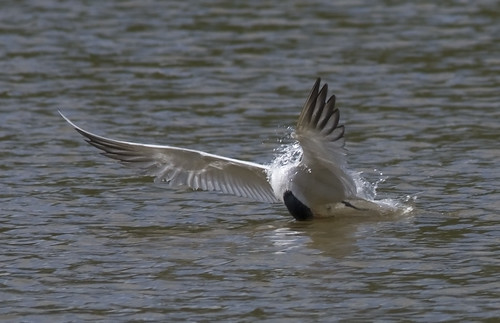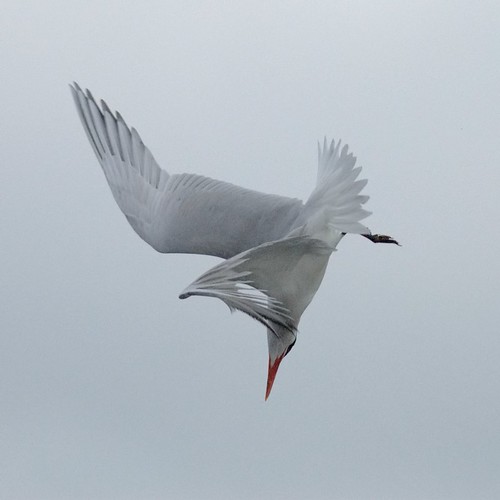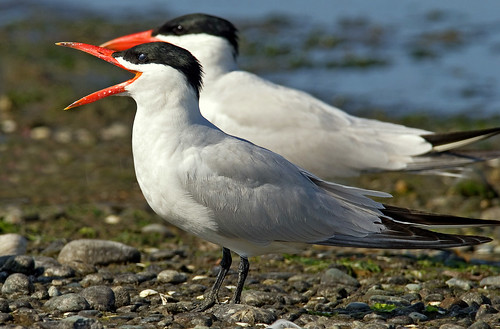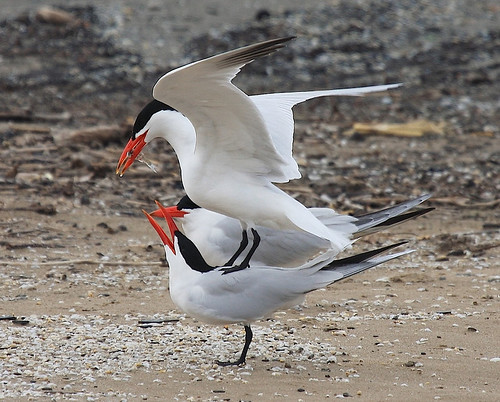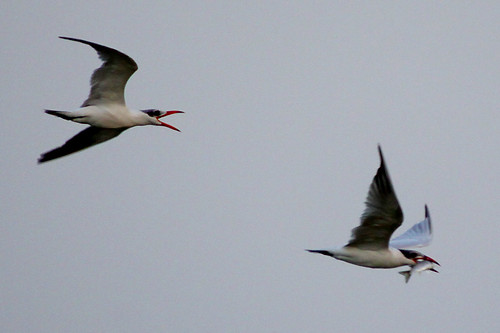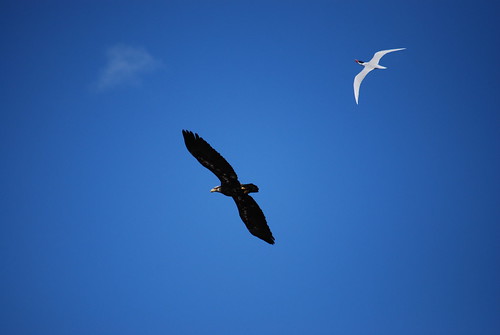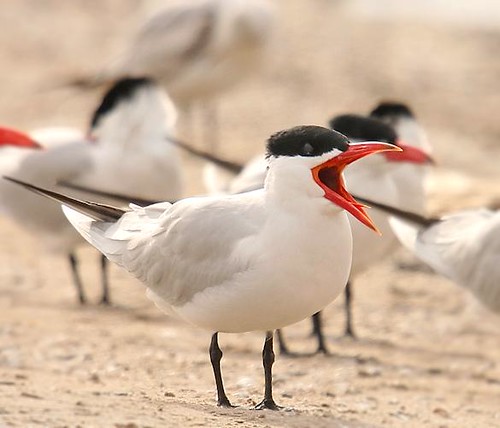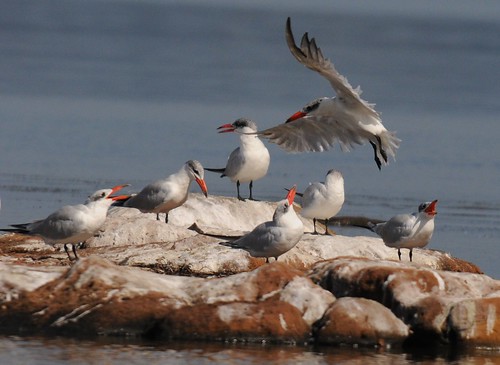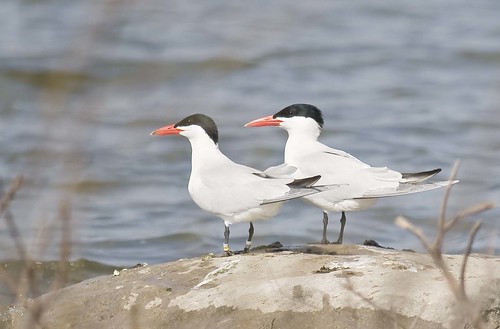This could have been almost anywhere in the world as Caspian Tern and Osprey share status as among the most cosmopolitan birds. I can imagine a young osprey trying to steal a fish from the tern or both birds hunting a shoal of larger bait fish. What a great shot.
Thursday, November 26, 2009
Sunday, September 20, 2009
A 'bad' tern of the word...
Thursday, September 17, 2009
Caspian Terns prominent at 3 of the 'Top 100 Birding Sites of the World'

A neighbor dropped by with Dominic Couzen’s book "Top100 Birding Sites of the World" and I immediately flipped to the index to see where Caspian Terns might be noted.
The results are that Caspian Terns are noted at three of 100 locations and each is interesting in its own way.
p 65:
p 127:
p 133: Gambia River,
The best place in the world to see Caspian Terns isobviously at the largest colony in the world and that is currently in the Columbia River Estuary of Oregon,
Wednesday, September 2, 2009
caspian tern drama
Growing up can be a drama in the life of Caspian Terns and much of it is not understood. This photo captures the tension that surrounds many recently fledged Caspian Terns in that there is a delivery landing, an adult on the ground vocalizing, and another adult ready to fly. Caspian Terns have the longest or one of the longest periods of parental care for a seabird as they continue to feed during migration and on the winter grounds. This youngster may or may not be the offspring of the tern with the fish, but it is certain to be making a weee weee begging call. Adults that are not related often are aggressive towards young that are not their own probably to prevent piracy from their own chicks. Wish I was where ever this photo was taken.
Monday, August 31, 2009
The momment of truth ...
In this moment I'd love to know what the tern is seeing. Are its eyes closed, covered by the nictitating membrane, or wide open making last nano-second modifications to snapping the prey. Earlier I was positing about the relative value of foot position going into and coming out of dives. Here it surely seems the tern has extended legs and is pushing off the water just as it prepares for a full flap down. Note there is no wing tip dimple on the water, but I'd be surprised if there weren't a couple in the second following. The wings, especially in the primaries, are flexed fully open to get the maximum lift away from the water.
Sunday, August 30, 2009
Caspian Tern playing with a crappie
Based on osprey1050's description it seems this Caspian Tern may have been playing with the fish. I would not be the least bit surprised if a second Caspian Tern in proximity that was this bird's youngster. Caspian Terns have a long period of parental care that anecdotally includes 'teaching' them to fish. August is the major month for post-breeding migrants to be moving south.
A wild turn in Finland
Turn tern puns are so easy to make, but this Caspian Tern in Finland is making a twist of the body that is nothing to laugh about. Knowing that these types of maneuvers are critical for successful plunge diving is always a concern when fitting harnesses on terns for telemetry.
Best feet forward?
The obvious amazing element of this photo is the bill has just cut the water without a ripple yet to break. The gape is open ready to grasp some hapless fish or perhaps it will be all splash and no lunch. Less conspicuous is the posture of the feet. As well as I know Caspian Terns I realize I don't know why the feet are forward in lieu of back. It would seem more stream lined to have them far back like the Pelicaniformes in their underwater pursuit for fish. Perhaps the feet forward are in position to allow for a quick burst off of the water. Caspians are not ones to sit and float on the water like a gull or even some of the smaller terns.
Wednesday, August 26, 2009
The last thing the fish saw was a big red bill
This photo has consistently ranked as one of the most interesting on Flickr and was the image I had in my mind when I read the wonderful species profile about Caspian Terns in the Sept/Oct BirdWatcher's Digest. Jim McCormac wrote a great article with some wonderful metaphors and comparisons that I found to be original and compelling. He was very gracious in mentioning this blog and the work I do with undergraduates at Willamette University. Birds have a special attraction that brings people together in a novel way. It was a world class turn of events to get to share some insights with the Bird Watcher's Digest readership. Any and all are encouraged to correspond with me directly about this great bird.
Friday, August 7, 2009
Dinner time in the Great Lakes
This photo shows a Caspian Tern colony in what is in many ways the most important week of the annual cycle and this year is a good one at Lake Ontario's Hamilton Harbour. The inference of great year is the large number of nearly fledged or recently fledged chicks. The chicks are every bird in the photo with speckling or chevrons marking the back of the wings (or mantle). Also you can see these same younger birds have orange bills instead of the intense red of the adults.
The fish coming to its final fate is around 14-15 cm and appears to be a clupeid of some kind.
Caspian Tern Flexible Billing
This photos shows the small amount of flexibility that is characteristic of many birds, especially the Charadriformes. The flexibility is due to a thinness at the base of the maxilla suture and probably adds to the capacity to hold and manipulate prey. This flexibility is also in part due to the quadrate bone at the base of the jaw. These characters together are among those that separate birds from their raptor-like relatives in the Dinosauria.
Tuesday, June 2, 2009
Frozen
Having watch Caspian Terns for more than a decade I have imagined taking this exact same photo a thousand times, but I never had my 'tern." You can see the tern's face reflected!
Wonder if the fish was captured in this 10 point dive.
Saturday, May 30, 2009
Caspian Tern @ Eagle River near Juneau, Alaska
This is fine photo of a Caspian Tern, but it is blog-worthy because of where and when the photography captured this shot. In late May Caspian Terns that are going to initiate breeding in western North America are still wandering around in small numbers, but most are on eggs by now and the first chicks are not far away. This Caspian Tern is 378 miles south from the Copper River delta which has breeders and is then 860 miles north of the colony at Dungeness Spit, Washington. If it was carrying fish in mid June, this would be HIGHLY suspicious breeding activity.
Wednesday, May 27, 2009
Food and Sex
This photo is a wonderful profile of the behaviors immediately preceding copulation in Caspian Terns. The male is balancing on top of the female's back with a small cyprinid (6-7 cm) long in his bill. The female is not quite in the lordotic curvature (fully swayed back with raised tail) that will allow the male to turn his tern tail under hers in order to make the 'cloacal kiss' necessary to transfer gametes. It almost certain the female is making a highly pitched call reminiscent of a chick begging for food. Often copulation follows soon after (<10 secs) the female takes the fish, but I have seen females take the fish and then dump the male and males that eaten the fish after a cop.
What happened to sharing??!!
Of the many wonderful things about science vocabulary is that the best term describe what is happening in this potentially ... bad tern of events is "PIRACY!" Piracy is whenever intraspecific stealing of food occurs and is a regular part of the behavior of small percentage of Caspian Terns, especially when the fish are large and conspicuous like this one.
Thursday, May 21, 2009
Caspian Terns in Kuwait
These Caspian Terns in Kuwait (29.31722, 47.87222) are in what reminds me of post-breeding habitat in Mexico's western coast. The photo is fascinating to me because it shows 7 adults in breeding plumage and then the tern second from the left is a young of the year. The tern to its right also appears to be a youngster, but could be an adult moulting into non-breeding plumage. I would guess these birds bred in eastern Africa between November and February before migrating north, but it is only a guess. The Far eastern curlews are probably heading north to breed, so it is a very interesting mix of birds indeed.
Ron Johnstone & John Darnell of the Western Australian Museum
Ron Johnstone, Curator of Ornithology, and John Darnell, Research Associate, of the Western Australian Museum of Science & Culture show off a drawer of 3 Caspian Terns in the research collections. They shared an amazing amount of insight about the distribution and behavior of terns in general and Caspians specifically during an afternoon visit by David Craig and Erik Willis of Willamette University.
Wednesday, May 13, 2009
Immature Baldy chased by Caspian
This shot shows the huge attitude Caspian Terns have and the attention they give to potential predators like Bald Eagles. This photo as one of few by Ben Retlin taken on the bay side of the Bayocean Spit which comprises the western border of the Tillamook Bay in Oregon. They were taken on April 30, 2009.
Tuesday, May 12, 2009
Caspian Terns and Nictitating
This Caspian Terns appears to yawning and is caught in a moment with it is blinking its nictitating membrane, but not its eye-lid.
I have found the secret resting place of the Caspian Terns!!!
Caspian Terns do seem to have spots they like to loaf at that are discrete from other waterbirds if they get the chance to use them. In Mexico and Australia I have found they are much more common in the freshwater parts of estuaries.
Sunday, May 3, 2009
Banded Caspian in Bloomingdale, Ontario
This Caspian Tern was probably marked as part of the historical research in Hamilton Harbour. The work in Lake Ontario has included some very innovative efforts to promote the coexistence of Caspian Terns and urban development.
Caspian Tern Nesting Raft
http://www.science.mcmaster.ca/Biology/Harbour/RESTOR/CASPIAN.HTM
Lampman K., Taylor M. & Blokpoel H. (1996) Caspian terns (Sterna caspia) breed successfully on a nesting raft. Waterbirds, 19, 135–138
James S. Quinn and Jane Sirdevan "Experimental measurement of nesting substrate preference in Caspian terns, Sterna caspia, and the successful colonisation of human constructed islands" in Biological Conservation
Volume 85, Issues 1-2, July-August 1998, Pages 63-68
Sunday, April 5, 2009
Least Tern with fish in it's beak
The fish in the bill of this this Least Tern appears to be a juvenile bass (Micropterus sp.). I would guess Large-mouth bass (M. salmoides), but the fact that the spotting along the dorsal line is so heavily broken suggests a small mouth (M. dolomieui). If the bill length is close to the average of 28 mm (Birds of North America Online), then the fish is at least 60 cm or a little more than 2 bill lengths.




